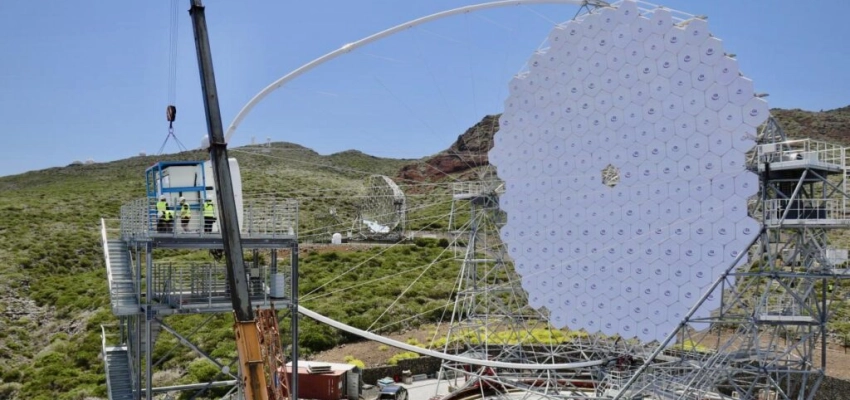Astronomy with a View: La Palma, Still the Attic of Knowledge (and Soon, Home to the LST-4)

From one of the cleanest and most stable peaks on the planet for sky observation, La Palma is once again looking decisively toward the future. The Roque de los Muchachos Observatory, located at the top of the island, is preparing to host the LST-4, the fourth large-size telescope of the international Cherenkov Telescope Array (CTA) project. This addition is not just a reinforcement: it is a decisive step toward a new way of exploring the Universe.
Here you can watch a fascinating video of the installation of the LST-4 camera at the ORM, published by the IAC.
What can the LST-4 observe?
Unlike conventional telescopes that capture visible light—like a very powerful camera—the LST-4 is designed to detect very high-energy gamma rays, which are extremely fast and energetic subatomic particles arriving from outer space. These particles cannot be directly observed from Earth, but when they collide with the atmosphere, they produce a brief flash of light known as Cherenkov radiation. The LST-4, with its 23-meter diameter mirror and near-instant reaction capacity, detects these flashes and reconstructs events that happened millions of light-years away.
Thanks to this technology, the LST-4 will allow us to:
- Detect the remnants of supernovae, the explosions of massive stars. These events are not only spectacular: they are cosmic forges where heavy elements in the periodic table are created. If you wear a gold ring, that gold was born in a supernova. The LST-4 will help study these regions with more precision than ever before.
- Observe the energy jets of supermassive black holes, which lie at the center of galaxies. Some of these black holes, called blazars, emit gamma rays as they consume matter. They act like cosmic lighthouses pointing directly at us, and studying them can help us understand how galaxies evolve.
- Search for signs of dark matter, a type of matter that neither emits light nor can be directly seen, but whose existence we infer through its gravitational effects. The LST-4 can help detect particles that may be generated when dark matter decays or collides—a major pursuit in modern physics.
- Capture ultra-fast transient events, like gamma-ray bursts, which last only seconds and may originate from billions of light-years away. These events are so brief and unpredictable that very few instruments in the world can react in time. The LST-4 can.
- Investigate the cosmic gamma-ray background, a kind of energetic “fog” that fills the Universe. Its structure could hold clues about the origin of the cosmos, the accelerated expansion of the Universe, or the presence of still-unknown phenomena.
To give you a sense: if traditional optical telescopes are like binoculars scanning the horizon from a ship, the LST-4 would be more like a high-precision radar that detects distant storms beyond the visible line, analyzing the waves and echoes they leave behind. It is a different way of “seeing”—based on particles rather than light—but a powerful form of observation nonetheless.
A scientific, social, and economic infrastructure
The LST-4 will not arrive on its own. Its installation requires advanced scientific infrastructure, which has already begun with the construction of the base that will support it at the Roque de los Muchachos Observatory. This platform must not only support a structure weighing over 100 tons, but also ensure millimetric precision in the telescope’s orientation and positioning.
This undertaking represents more than just a technological advance. It has an impact on three fundamental levels:
- Scientific: It positions Spain—and especially the Canary Islands—as a key player in one of the most ambitious scientific collaborations on the planet. The LST-4 is part of CTA, an international network of more than 100 telescopes across both hemispheres, designed to operate as a single global observatory. La Palma will host the northern array, and this new LST will be one of its central instruments.
- Social: The presence of scientific facilities at this level is a driver of education, outreach, and training. It inspires students and young people, brings science closer to society, and creates opportunities to develop talent on the island itself. Astrophysics is not just for a select few—it is a generator of shared knowledge.
- Economic: The construction and operation of the LST-4 creates local employment, boosts engineering and tech companies, and strengthens the island’s economic fabric. Moreover, scientific tourism—visitors who come to the island to learn about its observatories, skies, and research—is an emerging asset that adds to La Palma’s natural appeal.
La Palma is not just a beautiful place to see stars. It is one of the world’s most important astronomical sites. Its altitude, clean and stable atmosphere, and protection from light pollution make it a true gateway to the Universe. With every new project, it reaffirms its role as an international benchmark in science, innovation, and sustainability.
The LST-4 will be a new window into the cosmos. But from the heights of the island, it will also be a powerful reminder that looking up at the sky is still one of the best ways to build a future on Earth.

